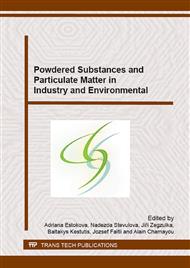p.197
p.205
p.213
p.221
p.228
p.234
p.240
p.246
p.252
Determination the Availability of Chromium from Powdered Cement Composites Containing Blast Furnace Slag
Abstract:
Nowadays, cement composites often contain a certain amount of waste materials, which can lead to increased heavy metals leaching. Important environmental indicator of the suitability of concrete is a leachability of chromium. In this paper, concrete samples containing special admixture based on the blast furnace slag as replacement of Portland cement (65%, 75%, 85% and 95%, respectively) as well as reference sample containing only a Portland cement were analyzed. Availability test was used to study the maximum chromium leaching from finely ground cement composites samples. The findings revealed that the leachability of hexavalent chromium from the samples containing 65 and 75 wt. % of slag-based additive was 4.59 and 1.70 times higher, respectively then the leachability of hexavalent chromium from the samples containing no slag. On the other hand, the 85 and 95 wt. % slag-containing-samples provided the Cr (VI) leachability by 26 and 41 % lower than the samples without any slag addition. Regarding the slag containing samples, the higher content of slag-based additive was in concrete sample, the lower leachability of Cr (VI) was detected.
Info:
Periodical:
Pages:
246-251
Citation:
Online since:
October 2015
Authors:
Keywords:
Price:
Сopyright:
© 2016 Trans Tech Publications Ltd. All Rights Reserved
Share:
Citation:


